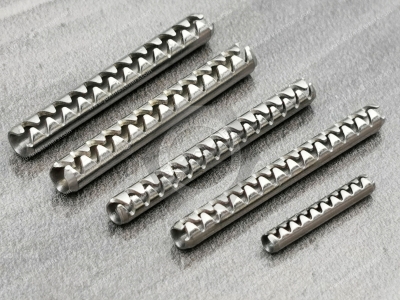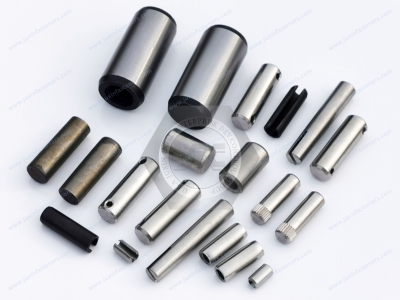Call Us
+86 136 6007 9809
Call Us
+86 136 6007 9809
Nov. 03, 2023
DIN 94 Split Pins (What are the characteristics of Split Pins?
Also known as split pins, these have one prong slightly longer than the other, so they're easy to open. Bend the prongs outward to secure them. Use them to tie the ends of clevis pins and shafts to keep components in place.
Steel pins have good strength. Pins with a zinc-plated finish have some corrosion resistance. Pins with a cadmium yellow-chromate plated finish have good corrosion resistance and meet MS-24665 for dimensions, material, and finish.
18-8 stainless steel pins balance strength and corrosion resistance. They may be mildly magnetic. Passivated pins provide added protection against corrosion and oxidation.
Three hundred sixteen stainless steel pins have the best corrosion resistance of our stainless steel pins and are as strong as 18-8 stainless steel pins. They may be mildly magnetic.
Aluminum pins are one-third the weight of stainless steel pins and resist corrosion. They are nonmagnetic.
Brass pins are rust-resistant, electrically conductive, and nonmagnetic.
Four hundred nickel pins are solid and wear-resistant. They withstand salt water and caustic chemicals and may be mildly magnetic. Pins meet MS-24665 for dimensions, material, and finish. They are also known as Monel.
A stainless steel split pin is a kind of stainless steel metal hardware commonly known as a stainless steel spring pin; the split pin's role in the threaded connection is to prevent loosening, insert the split pin into the nut groove, and the bolt tail hole, and wrench the split pin tail, to prevent the relative rotation of the nut and bolt. The production of materials is generally Q235, copper alloy, SUS201 stainless steel, and SUS304 stainless steel. Stainless steel split pin material toughness requirements are relatively high; each foot's stainless steel split pin should withstand repeated bending, and the bending part should not break or crack. Bending method: pull the stainless steel cotter pin, any of its feet partially clamped in the test mold (should not occur flattening phenomenon); then the stainless steel split pin bending 90 °, back and forth once for a bending. The test speed should not exceed 60 times/min.
Main functions of split pins:They are used for threaded connections to prevent loosening.
After the nut is tightened, the split pin is inserted into the nut slot, and the hole at the bolt's end and the divided pin's end is wrenched away to prevent the relative rotation of the nut and the bolt. A split pin is a kind of metal hardware commonly known as a spring pin.
1. Split pins are standardized as DIN94. They are a kind of metal hardware commonly known as spring pins or safety pins. They are widely used in high-quality steel, elasticity, and reasonable material production and have become.
2. Standard range of nominal specifications for 0.6 ~ 20mm
3. Split pin material: carbon steel, copper alloy, stainless steel
4. Characteristics: Each foot of the cotter pin can withstand repeated bending, and there is no breakage or crack in the bending part.
5. Defective split pins: cotter pins surface burrs, irregular shape, and harmful defects.
The role of cotter pins: Split pins and closed pins are generally used in various types of fixtures on the bolt, mainly playing a role in limiting.
Advantages: Closed pins apply to many fixtures, are applicable surfaces, and are easy to use.
Disadvantages: Easy to loosen, ordinary cotter pins are easily corroded.
W type and R type difference: W-type locking pins are generally used on disk insulators, and R-type locking pins are usually used on insulators.


Split pin open one side or both sides:Split pins are open on both sides. When installing cotter pins, add a flat cushion on the front side, fit a suitable cotter pin, and fold both sides of the split end so it is not easy to disconnect and fall off. A split pin is a mechanical part. To avoid damage to the hole wall, you can add grease lubricant in the pinhole; this part's production requires high-quality steel, elastic, and rigid materials.
1. Preparation: Tie the cotter pin and wire tightly, and prepare pliers and hammer.
2. Selection of location: Determine the location to be installed and mark the area with a pencil or pen to facilitate subsequent operations.
3. Drill holes: Use a drill to drill holes where the split pins are to be installed. The diameter of the holes should be the same as the diameter of the cotter pins so as not to be too large or too small.
4. Installation of the cotter pin: Place the split pin into the drilled hole, insert the wire into the divided pin with pliers, and gently tap the wire with a hammer to secure the split pin to the hole wall until the wire is fully returned.
5. Confirm Installation: Gently shake the Split pin by hand to confirm it is securely installed in the hole wall.
Split pin standard:Split pin standard range of nominal specifications for 0.6 to 20mm split pin, toughness split pin each foot should be able to withstand repeated bending, and in the bending part does not break or crack, eyelets should be made as far as possible round.
Split pin two feet of the cross-section should be round, but promised split pin two feet of the plane and the circumference of the intersection of the radius, split pin two gaps and two feet of the amount of misalignment should be no greater than the nominal specifications of the split pin, split pin promised to be made into an opening of the two feet of the inner plane of the angle should be in line with the specifications of split pins should not have a burr on the surface, irregularities and harmful defects.
Bending method: pull the split pin, either leg partially clamped in the test mold (should not occur flattening phenomenon); then the split pin bent 90 °, back and forth once for a bending. Test speed should not exceed 60 times/min. The best mold should be made out of a semicircular groove hole, and its diameter is the nominal specifications of the split pin. The jaws should have a rounded corner of r=0.5mm.
Eyelets should be made as round as possible.
The split pin, which is two feet of the cross-section, should be round, but the promised split pin is two feet of the plane and the circumference of the intersection of the radius.
A split pin, two gaps, and two feet of the wrong displacement should not exceed the split pin's nominal specifications.
Split pins promised to be made of openings; the angle between the two feet of the inner plane should be in line with the specifications.
Surface defects: The surface of split pins should be free from burrs, irregularities, and harmful defects.
What are the specifications for split pins?
Split pins are standardized to DIN94, with a standard range of nominal sizes from 0.6 to 20mm.
Split pin material: Carbon steel, copper alloy, stainless steel copper, etc.
Characteristics: The split pins on each foot can withstand repeated bending, and the bending part does not break or crack.
Substandard split pins: Split pins have burrs, irregular shapes, and harmful defects on the surface.
Role of cotter pins: Split and closed pins are generally used on the bolts of all fixtures, mainly to limit the position.
Advantages: Closed pins apply to many fixtures, are applicable surfaces, and are easy to use.
Disadvantages: Easy to loosen, ordinary split pins are easily corroded.
Surface defects: The surface of the split pin should not have burrs, irregularities, and harmful defects.
Bending method: Pull the split pin apart, clamp any straight leg part of it in the test mold (no flattening should occur); then bend the split pin by 90 °, back and forth once for a bending. Test speed should not exceed 60 times/min. The best mold should be made out of a semicircular groove hole, and its diameter is the nominal specifications of the split pin. The jaws should have r = 0.5mm rounded corners. The divided pin two feet of the cross-section should be round, the divided pin two feet of the plane, and the circumference of the intersection of the radius. A split pin, two gaps, and two feet of the wrong displacement should not exceed the nominal specifications of the split pin. Split pins open, and the angle between the inner planes of the two feet shall follow the specifications.
How to use split pins?
After the nut is tightened, insert the split pin into the nut groove and the bolt tail hole and wrench the end of the split pin away to prevent the nut and bolt from rotating relative to each other.
A split pin is a metal piece of hardware, commonly known as a spring or safety pin!
A split pin is a mechanical part; grease lubricant can be added to the pinhole to avoid damaging the hole's wall.
Split pins are commonly used in high-quality steel, an elastic material made of good.
Split pin standard DIN94, cotter pin standard range of nominal specifications for 0.6 ~ 20mm cotter pin, cotter pin material, carbon steel: Q215, Q235 copper alloy: H63, stainless steel: Cr17Ni7, 0Cr18Ni9Ti.
Split pin installation specifications:
1. The split pins used should not be broken, cracked, or rusted;
2. The nominal specification of the cotter pin should be equal to the diameter of the split pinhole;
3. It should be split tightly by the root so that the split pin does not tamper;
4. The split pin opening must be symmetrical; both feet after splitting shall be rolled on the round pin or shaft so that the arc of the split part is parallel to the arc of the round pin or shaft and as close as possible to the round pin or shaft so that the two openings at an angle of > 180 °
. Replacing cotter pins with wires or other materials is strictly prohibited.
Split pin assembly:
1. Insert the split pin into the cylindrical pin by hand or pliers; do not drive the split pin in with a hammer.
2. Break the split pin with a screwdriver.
3. The split pin's principal breaking angle is 60°. If it touches the workpiece, the split pin can be rolled up.
4. When opening the split pin, make the separated part straight and symmetrical. It cannot be long or short with an R shape and on the gap.
5. Fixed slotted nut, the split pin opening angle is 60 ° in principle, appropriate screwing and rolling a few turns. However, the split pin should be rolled up when there is an obstruction or insufficient insulation distance from the surroundings.
If you are looking for high-quality automotive fastener screws & all kinds of plastic fasteners or technical support for structural design, please get in touch with me. Use our new Product Finder tool, download our Product Catalog, and let us help you get custom parts.adelajonly@gmail.com. Thanks. Website: www.juxinfasteners.com
Contact Us
Tel.:
+86 020 8621 0320
+86 020 3121 6067
Technical Support:
Navigation
SEND INQUIREY